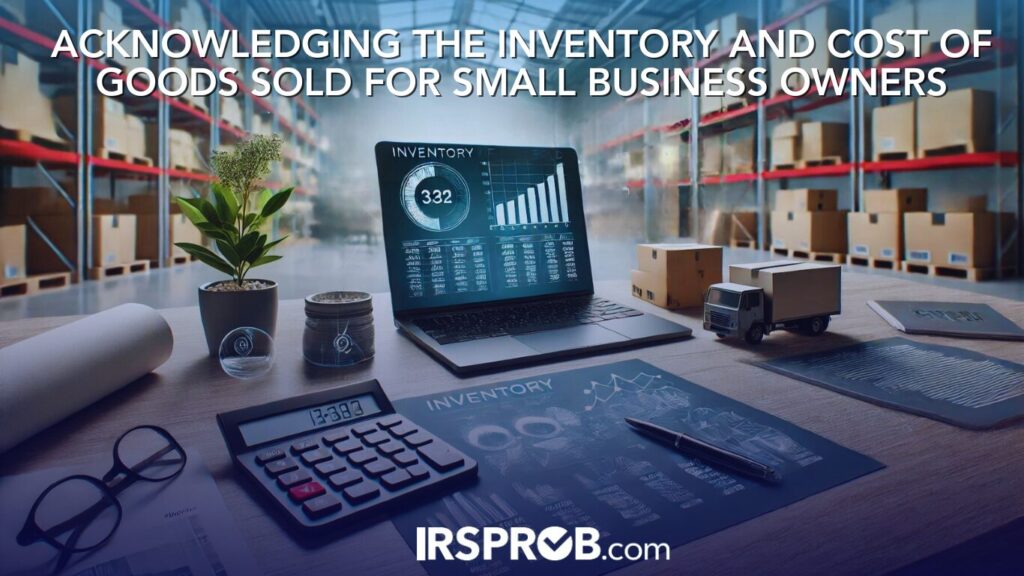
When it comes to running a successful business, especially one that involves manufacturing, production, or retail, inventory and the Cost of Goods Sold (COGS) play a critical role in determining your profitability. Proper management and accounting for inventory can impact your tax liabilities and overall financial health. This blog post will guide small business owners through the basics of managing inventory and COGS, with practical insights and considerations.
What is Inventory Accounting?
Inventory accounting is essential for businesses where the production, purchase, or sale of merchandise directly influences income. Generally, if your business involves managing physical products, you must account for your inventory to properly reflect gross profit.
For small business owners, specifically those with average annual gross receipts of $30 million or less, you may qualify as a small business taxpayer, which allows for simplified inventory accounting methods. For instance, small businesses can opt to treat inventory as non-incidental materials or supplies if it better reflects their financial practices. This flexibility can simplify tax filings while ensuring compliance.
How to Handle Cost of Goods Sold (COGS)
COGS refers to the direct costs involved in manufacturing products or purchasing them for resale. These expenses, which include the cost of raw materials, storage, and direct labor, are not deductible until the product is sold. As a result, managing COGS effectively is essential for tax planning.
Here’s a breakdown of the main components of COGS:
- Raw materials: The physical items that become part of your product.
- Direct labor: Costs associated with workers who manufacture your products.
- Storage costs: The expense of storing your products until they are sold.
- Indirect costs: Such as factory overhead, which can also be included under specific circumstances (i.e., if your business is subject to Uniform Capitalization (UNICAP) rules).
To calculate COGS:
- Start with the value of inventory at the beginning of the year.
- Add purchases and other related costs made throughout the year.
- Subtract the value of your inventory at the end of the year.
This formula ensures that you only deduct the costs associated with products that were sold, not the ones still sitting in inventory.
Inventory Identification Methods
There are several methods you can use to identify and value your inventory:
- Specific Identification Method: This method involves tracking the exact cost of each individual item in inventory, which is ideal for businesses that sell high-value or easily distinguishable products, like car dealerships.
- First-In, First-Out (FIFO): This method assumes that the first items purchased or produced are the first ones sold. It is commonly used by businesses where inventory does not significantly change in value over time.
- Last-In, First-Out (LIFO): This method assumes that the most recently acquired items are sold first. LIFO can be beneficial for businesses facing rising costs, but the method is more complex and requires IRS approval (through Form 970).
How to Value Your Inventory
Choosing the right method to value your inventory can have significant tax implications. Here are the common methods:
- Cost Method: This method uses the actual cost paid for the inventory, including both direct and indirect costs.
- Lower of Cost or Market: This method compares the cost of the inventory to its current market value and takes the lower of the two. It’s beneficial for businesses whose inventory has decreased in value.
- Retail Method: Used mainly by retailers, this method estimates the value of inventory by applying an average markup percentage to the retail price.
Choosing the right inventory valuation method can help lower your taxable income and increase profitability. For example, businesses that use the lower of cost or market method can take advantage of declining market prices, reducing their COGS and improving their tax position.
The Importance of Physical Inventory
It’s crucial to regularly conduct physical inventory counts to ensure that your books match the actual inventory on hand. Discrepancies between book and physical inventory can affect your COGS and overall profitability. Make adjustments accordingly, and if you face losses due to theft, damage, or other causes, these may be accounted for in your COGS.
Planning for Uniform Capitalization (UNICAP) Rules
If your business is subject to UNICAP rules, you must capitalize certain direct and indirect costs related to production or resale. Businesses with average annual gross receipts over $30 million are subject to these rules and must include indirect costs in their inventory valuation, which impacts your COGS.
For smaller businesses not subject to UNICAP, the rules are less stringent, providing greater flexibility in how costs are capitalized.
Additional Considerations for Business Owners
Inventory and COGS can significantly affect a business’s tax burden, making it important to stay compliant with IRS rules. For businesses that maintain inventory, even small changes in how inventory is accounted for can influence cash flow and profitability.
If you are unsure about the best method to use for inventory or COGS, or how to optimize your tax strategy, consulting with a tax professional can ensure you comply with IRS regulations while minimizing your tax liabilities.
Key Takeaways:
- Inventory accounting is crucial for businesses that sell physical products.
- COGS includes costs directly tied to manufacturing or purchasing goods.
- Use one of several methods to value inventory—specific identification, FIFO, or LIFO, depending on what best fits your business.
- Periodically conduct physical inventory counts to ensure accuracy.
- Businesses subject to UNICAP must capitalize direct and indirect costs.
- The right inventory accounting method can provide significant tax advantages.
For more details on tax strategies and inventory accounting, or to ensure your business complies with these rules, contact us at IRSProb.com. We can help tailor a tax strategy that fits your business needs while ensuring compliance with all IRS regulations.








